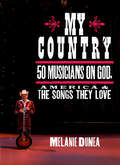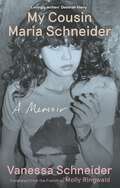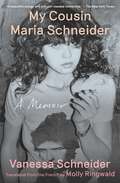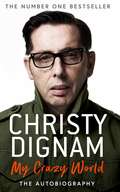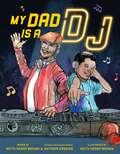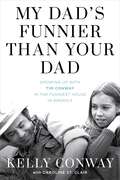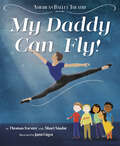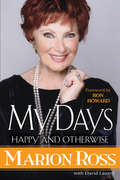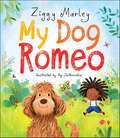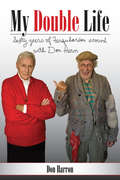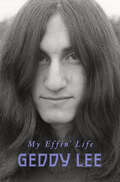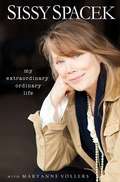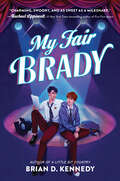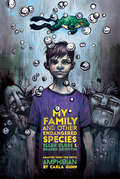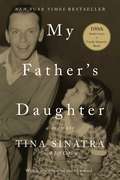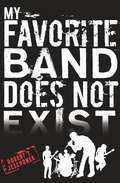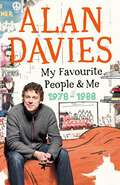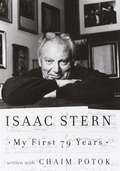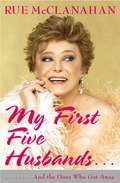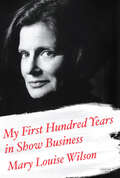- Table View
- List View
My Country: 50 Musicians on God, America & the Songs They Love
by Melanie DuneaNow in paperback, a volume of stunning photographs of 50 country music icons and intimate accounts of their thoughts on God, America, and their favorite songs.Award-winning photographer and author of My Last Supper, Melanie Dunea traces the throughlines from country music's gritty roots to the chart-topping chanteuses of today, presenting beautiful, imaginative, and revealing photographs of icons ranging from Taylor Swift to Wynnona Judd to Little Jimmy Dickens and conducting interviews that ask stars to discuss their musical roots and inspirations, their defining moments, and what makes country music the heart and soul of America.As the music industry fractures and suffers from flagging sales, country music has enjoyed explosive growth and unprecedented popularity. This totally unique book will be a must-own (and a perfect gift) for fans of the old time country twang and the millions who love the glitz and glamour of today's country-pop. My Country is a music-lovers dream, and in this more inexpensive, accessible market the book is sure to find its core audience amongst country music's legions of fans.
My Cousin Maria Schneider
by Vanessa Schneider"Lovingly written" Deborah Harry"An exquisite portrait of a tragic heroine" Violaine HuismanA spare, heartbreaking memoir and tribute to Maria Schneider, the 1970s movie starlet who catapulted to fame in the controversial film Last Tango in Paris-only to live the rest of her life plagued by scandal-as told from the perspective of her adoring younger cousin.The late French actress Maria Schneider is perhaps best known for playing Jeanne in the provocative film Last Tango in Paris, directed by Bernardo Bertolucci and released to international shock and acclaim in 1972. It was Maria's first major role, alongside film legend Marlon Brando, when she was barely eighteen years old. The experience would haunt her for the rest of her life, traumatizing her and sparking a tabloid firestorm that only ceased when she began to retreat from the public eye nearly two decades later.To Maria's much younger cousin, Vanessa Schneider, Maria was a towering figure of another kind-a beautiful and fearsome fixture in Vanessa's childhood, a rising star turned pariah whose career and struggles with addiction won the family shame and pride in equal measure. Here, Vanessa recounts the challenges of their overlapping youths and fraught adulthood and reveals both the tragedy and inevitability of Maria's path in a family plagued by mental illness and in a society rife with misogyny.Unsentimental and suffused with deep love, My Cousin Maria Schneider is the story of a talented artist and the cousin who admired her, and of exploitation and how its lingering effects can reverberate through a lifetime.
My Cousin Maria Schneider: A Memoir
by Vanessa Schneider&“A beautiful eulogy and a much-needed corrective&” (The New York Times)—a love letter to Maria Schneider, the 1970s movie starlet who catapulted to fame in the controversial film Last Tango in Paris—only to live the rest of her life plagued by scandal, as told from the perspective of her adoring younger cousin.The late French actress Maria Schneider is perhaps best known for playing Jeanne in the provocative film Last Tango in Paris, directed by Bernardo Bertolucci and released to international shock and acclaim in 1972. It was Maria&’s first major role, alongside film legend Marlon Brando, when she was barely eighteen years old. The experience would haunt her for the rest of her life, traumatizing her and sparking a tabloid firestorm that only ceased when she began to retreat from the public eye nearly two decades later. To Maria&’s much younger cousin, Vanessa Schneider, Maria was a towering figure of another kind—a beautiful and fearsome fixture in Vanessa&’s childhood, a rising star turned pariah whose career and struggles with addiction won the family shame and pride in equal measure. Here, Vanessa recounts the challenges of their overlapping youths and fraught adulthood and reveals both the tragedy and inevitability of Maria&’s path in a family plagued by mental illness and in a society rife with misogyny. Unsentimental and moving, My Cousin Maria Schneider is a love letter to a talented artist and the cousin who admired her, and a powerful story of exploitation and how its lingering effects can reverberate through a lifetime.
My Crazy World: The Autobiography
by Christy DignamChristy Dignam, lead singer of Aslan and one of Ireland’s greatest rock stars, reveals all in this extraordinary tale of excess and devotion to his music. Growing up in Finglas, Dublin, there was only one thing Christy Dignam ever wanted to do – and that was sing. By the early 1980s, he had formed the band Aslan, part of a new wave of acts coming out of Ireland. Repeatedly chewed up and spat out in the feeding frenzy to sign 'the next U2', they stuck to their principles. developed a loyal following, and their first album Feel No Shame went to No 1 in their home country, showcased by the song ‘This Is’, which Christy proudly acknowledges has become 'part of Ireland's DNA'. But just as America seemed ready to fall for Aslan, Dignam was battling with heroin addiction, perhaps caused by having been sexually abused as a child, and so he was kicked out of the band. In 1993, after five years in the wilderness, he rejoined Aslan, leading the outfit to a triumphant second coming, despite struggling with further drug problems and serious illness. In this compelling memoir, Dignam looks back over his long career, vividly bringing to life the good times and the bad, but always remembering that at the heart of it all are his songs and his family.
My Dad Is a DJ
by Kathryn Erskine Keith Henry BrownNational Book Award winner Kathryn Erskine teams up with Keith Henry Brown on this lyrical picture book that celebrates music and Black identity.Trevor’s dad is a DJ, and he always picks the best music—tunes jivin’, beat drivin’, high fivin’!—he’s DJ Dap Daddy!But after his parents split up and Dad moves out, Trevor feels like the pitch doesn’t fit between them. Trevor has his own music now—hip-hop—and Dad can’t seem to let go of his old soul favorites. As the end-of-year dance approaches, Trevor and his father will have to find their new groove to get the party started.My Dad Is a DJ is a hip-hoppin’, beat boppin’, tunes poppin’, not stoppin’ story of a father and son’s shared love of music and each other.
My Dad's Funnier than Your Dad: Growing Up with Tim Conway in the Funniest House in America
by Kelly ConwayComic and television star Tim Conway (The Carol Burnett Show, McHale's Navy, Dorf) enjoyed enormous popular appeal. In this humorous, loving, and surprising memoir, Tim's eldest of his six children, Kelly, reveals that the Conway home life was as riotous as some of her father's legendary comedy sketches. Kelly Conway allows readers an intimate look at an American childhood set in 1970s and 80s Los Angeles, from the studios of CBS to the racetrack of Santa Anita Park where her father taught his kids the art of horse betting. Tim Conway took his hilarious creativity off the set to the family home, where he acted as the ringmaster to six unruly lion cubs—and often lit the fuse of their short-tempered mother, Mary Anne. Kelly takes us through the fascinating world of entertainment from the lens of her dad&’s television stardom to her own career in costume design and wardrobe styling, using the lessons her father taught her about holding her own in the often cruel world of show business. But it&’s not until Kelly realizes that she must find the courage to fight for her dad when he faces a devastating life change that her steadfast commitment to him becomes clear—although it will mean losing lifelong relationships, and at times, facing harsh criticism. My Dad's Funnier Than Your Dad is Kelly&’s love letter to her father, an account of the warm, laugh-filled world of her childhood. And when life brings sadness instead of smiles, it&’s the mutual respect and fierce devotion that Kelly shares with her famous father which ultimately defines the true meaning of love.
My Daddy Can Fly! (American Ballet Theatre)
by Thomas Forster Shari SiadatFor young dance lovers, a picture book about a young boy whose father has the unique position as a ballet dancer. Written by American Ballet Theatre principal dancer Thomas Forster.Ben and his friends are playing in their favorite part of the classroom-- the dress-up corner! They are talking about what they want to be when they grow up. Rachel wants to be a tae kwon do master, Dixie wants to be a doctor like her auntie, and John wants to be a teacher just like their teacher, Mr. Underwood. But when Ben says he wants to fly just like his daddy, his friends are sure his daddy must be a pilot. Ben tells his friends that they aren't even close, but he offers a few more clues. His daddy is strong, gentle, fierce, and fast. His friends have lots of guesses, but no one lands on the right one until Ben gives them the biggest clue of all. Written by a dad who is also a professional ballet dancer, this story will appeal to all ballet dancing children and their loved ones.
My Damage: The Story of a Punk Rock Survivor
by Keith Morris Jim RulandKeith Morris is a true punk icon. No one else embodies the sound of Southern Californian hardcore the way he does. With his waist-length dreadlocks and snarling vocals, Morris is known the world over for his take-no-prisoners approach on the stage and his integrity off of it. Over the course of his forty-year career with Black Flag, the Circle Jerks, and OFF!, he's battled diabetes, drug and alcohol addiction, and the record industry...and he's still going strong.My Damage is more than a book about the highs and lows of a punk rock legend. It's a story from the perspective of someone who has shared the stage with just about every major figure in the music industry and has appeared in cult films like The Decline of Western Civilization and Repo Man. A true Hollywood tale from an L.A. native, My Damage reveals the story of Morris's streets, his scene, and his music-as only he can tell it.
My Days: Happy and Otherwise
by Marion RossFor eleven seasons, she was head of one of America's favorite television households. Now meet the lovable real-life woman behind the Happy Days mom.Before she was affectionately known to millions as “Mrs. C.,” Marion Ross began her career as a Paramount starlet who went on to appear in nearly every major TV series of the 1950s and 1960s—including Love, American Style, in which she donned an apron that would cinch her career. Soon after came the phone call that changed her life . . .In this warm and candid memoir, filled with recollections from the award-winning Happy Days team—from break-out star Henry Winkler to Cunningham “wild child” Erin Moran—Ross shares what it was like to be a starry-eyed young girl with dreams in poor, rural Minnesota, and the resilience it took to make them come true. She recalls her early years in the business, being in the company of such luminaries as Humphrey Bogart and Lauren Bacall, yet always feeling the Hollywood outsider—an invisibility that mirrored her own childhood. She reveals the joys of playing a wife and mother on TV, and the struggles of maintaining those roles in real life. But among Ross's most heart-rending recollections are those of finally finding a soulmate—another hope made true beyond her expectations.Featuring producer Garry Marshall's final interview—as well as a touching foreword from her “TV son” Ron Howard, and a conversation with her real-life son and daughter, Marion Ross's inspiring story is also a glowing tribute to all those who fulfilled her dreams—and in turn, gave us some of the happiest days of our own lives.
My Dog Romeo
by Ziggy MarleyZiggy Marley's ode to his four-legged friend Romeo becomes a picture book that is sure to touch the hearts of dog lovers everywhere. "A delight for young readers . . . It’s sure to inspire a love of books, and warm and loving sto
My Dog Romeo
by Ziggy MarleyZiggy Marley’s ode to his four-legged friend Romeo becomes a picture book that is sure to touch the hearts of dog lovers everywhere.“A delight for young readers . . . It’s sure to inspire a love of books, and warm and loving storytime bonding between you and your child.” —Miami Times Online“My Dog Romeo”—a single on More Family Time, the follow-up children’s album to the GRAMMY Award–winning Family Time—is a playful and endearing tribute to Ziggy Marley’s beloved pet dog Romeo. Opening with Romeo’s barking, Marley sings of his great love and friendship with his four-legged friend.Now, with beautiful illustrations by Ag Jatkowska—illustrator of Marley’s debut picture book, I Love You Too—My Dog Romeo becomes a vibrant picture book that follows a child and a dog throughout their days, sharing their love of music and play. The perfect accompaniment to Marley’s charming children’s album, My Dog Romeo is sure to be a hit among young, old, and, of course, our furry friends.
My Double Life: Sexty Yeers of Farquharson Around with Don Harn
by Don HarronThe colourful story of Don Harron’s 77-year career in the entertainment business. After 15 books about somebody else (mostly alter ego Charlie Farquharson) plus one book by his drag-queen character, Charlie’s rich city cousin Valerie Rosedale, Don Harron now presents the story of his 77-year stint in the entertainment business. The actor’s colourful career includes such highlights as making money in 1935 as a 10-year-old cartoonist doing mother-and-son banquets; winning an ACTRA Award as best radio host for Morningside; six stage shows on Broadway, three in London’s West End, and 10 years of Shakespeare in three countries; a Gemini Award for lifetime achievement; writing the lyrics for five musicals, including Anne of Green Gables; and being appointed to the Canadian Country Music Hall of Honours due to his appearances on Hee Haw. Whether playing a serious stage role or hamming it up as Charlie Farquharson, Harron is always insightful and provides a unique perspective on a long life in the entertainment business.
My Effin' Life
by Geddy LeeThe long-awaited memoir, generously illustrated with never-before-seen photos, from the iconic Rock and Roll Hall of Famer, Rush bassist, and New York Times bestselling author of Geddy Lee's Big Beautiful Book of Bass.Geddy Lee is one of rock and roll's most respected bassists. For nearly five decades, his playing and work as co-writer, vocalist and keyboardist has been an essential part of the success story of Canadian progressive rock trio Rush. Here for the first time is his account of life inside and outside the band.Long before Rush accumulated more consecutive gold and platinum records than any rock band after the Beatles and the Rolling Stones, before the seven Grammy nominations or the countless electrifying live performances across the globe, Geddy Lee was Gershon Eliezer Weinrib, after his grandfather was murdered in the Holocaust.As he recounts the transformation, Lee looks back on his family, in particular his loving parents and their horrific experiences as teenagers during World War II.He talks candidly about his childhood and the pursuit of music that led him to drop out of high school.He tracks the history of Rush which, after early struggles, exploded into one of the most beloved bands of all time.He shares intimate stories of his lifelong friendships with bandmates Alex Lifeson and Neil Peart—deeply mourning Peart’s recent passing—and reveals his obsessions in music and beyond.This rich brew of honesty, humor, and loss makes for a uniquely poignant memoir.
My Extraordinary Ordinary Life
by Maryanne Vollers Sissy SpacekIn her delightful and moving memoir, Sissy Spacek writes about her idyllic, barefoot childhood in a small East Texas town, with the clarity and wisdom that comes from never losing sight of her roots. Descended from industrious Czech immigrants and threadbare southern gentility, she grew up a tomboy, tagging along with two older brothers and absorbing grace and grit from her remarkable parents, who taught her that she could do anything. She also learned fearlessness in the wake of a family tragedy, the grief propelling her "like rocket fuel" to follow her dreams of becoming a performer.With a keen sense of humor and a big-hearted voice, she describes how she arrived in New York City one star-struck summer as a seventeen-year-old carrying a suitcase and two guitars; and how she built a career that has spanned four decades with films such as Carrie, Coal Miner's Daughter, 3 Women, and The Help. She details working with some of the great directors of our time, including Terrence Malick, Robert Altman, David Lynch, and Brian De Palma-who thought of her as a no-talent set decorator until he cast her as the lead in Carrie. She also reveals why, at the height of her fame, she and her family moved away from Los Angeles to a farm in rural Virginia. Whether she's describing the terrors and joys of raising two talented, independent daughters, taking readers behind the scenes on Oscar night, or meditating on the thrill of watching a pair of otters frolicking in her pond, Sissy Spacek's memoir is poignant and laugh-out-loud funny, plainspoken and utterly honest. My Extraordinary Ordinary Life is about what matters most: the exquisite worth of ordinary things, the simple pleasures of home and family, and the honest job of being right with the world. "If I get hit by a truck tomorrow," she writes, "I want to know I've returned my neighbor's cake pan."
My Fair Brady
by Brian D. KennedyMy Fair Lady meets the classic teen film She's All That in this charming and swoony new rom-com from Brian D. Kennedy, author of A Little Bit Country. Perfect for fans of What If It's Us and She Gets the Girl. Wade Westmore is used to being in the spotlight. So when he’s passed over for the lead in the spring musical, it comes as a major blow—especially when the role goes to his ex-boyfriend, Reese, who dumped him for being too self-involved.Shy sophomore Elijah Brady is used to being overlooked. Forget not knowing his name—most of his classmates don’t even know he exists. So when he joins the stage crew for the musical, he seems destined to blend into the scenery.When the two have a disastrous backstage run-in, Elijah proposes an arrangement that could solve both boys’ problems: If Wade teaches Elijah how to be popular, Wade can prove that he cares about more than just himself. Seeing a chance to win Reese back, Wade dives headfirst into helping Elijah become the new and improved “Brady.”Soon their plan puts Brady center stage—and he’s a surprising smash hit. So why is Wade suddenly less worried about winning over his ex and more worried about losing Elijah?
My Fair Ladies
by Julie WoskThe fantasy of a male creator constructing his perfect woman dates back to the Greek myth of Pygmalion and Galatea. Yet as technology has advanced over the past century, the figure of the lifelike manmade woman has become nearly ubiquitous, popping up in everything from Bride of Frankenstein to Weird Science to The Stepford Wives. Now Julie Wosk takes us on a fascinating tour through this bevy of artificial women, revealing the array of cultural fantasies and fears they embody. My Fair Ladies considers how female automatons have been represented as objects of desire in fiction and how "living dolls" have been manufactured as real-world fetish objects. But it also examines the many works in which the "perfect" woman turns out to be artificial--a robot or doll--and thus becomes a source of uncanny horror. Finally, Wosk introduces us to a variety of female artists, writers, and filmmakers--from Cindy Sherman to Shelley Jackson to Zoe Kazan--who have cleverly crafted their own images of simulated women. Anything but dry, My Fair Ladies draws upon Wosk's own experiences as a young female Playboy copywriter and as a child of the "feminine mystique" era to show how images of the artificial woman have loomed large over real women's lives. Lavishly illustrated with film stills, artwork, and vintage advertisements, this book offers a fresh look at familiar myths about gender, technology, and artistic creation.
My Family and Other Endangered Species
by Ellen Close Braden GriffithsNine-year-old Phineas interprets the world through his encyclopedic knowledge of animals, but some human behaviour is just too puzzling. Take for example his mom, who insists he learn to fall asleep on his own, even though all young mammals sleep with their mothers; or his dad, who recently picked up and left the family, a behaviour quite unlike other mate-for-life animals. And then there’s the constant news from his favourite TV station, the Green Channel, about how humans are ruining the environment, a fact Phin is growing increasingly anxious about. So when his fourth-grade class gets a White’s tree frog as a pet, all of Phin’s anxieties come to a boil.
My Father's Daughter: A Memoir
by Tina SinatraCelebrating the 100th anniversary of Sinatra’s birth, a startling, compelling, yet affectionate portrait of an American entertainment legend by his youngest daughter, who writes about the man, his life, the accusations, and about the many people who surrounded him—wives, friends, lovers, users, and sycophants—from his Hoboken childhood through the notorious “Rat Pack,” and beyond.Frank Sinatra seemed to have it all: genius, wealth, the love of beautiful women, glamorous friends from Las Vegas to the White House. But in this startling and remarkably outspoken memoir, his youngest daughter reveals an acutely restless, lonely and conflicted man. Through his marriages and front-page romances and the melancholy gaps between, Frank Sinatra searched for a contentment that eluded him. Tina writes candidly about the wedge his manipulative fourth wife, Barbara Marx, drove between father and daughter. My Father’s Daughter, with its unflinching account of Sinatra’s flaws and foibles, will shock many of his fans. At the same time, it is a deeply affectionate portrait written with love and warmth, a celebration of a daughter’s fond esteem for her father and a respect for his great legacy. Even now, as we celebrate the 100th anniversary of his birth, the world remembers Frank Sinatra as one of the giants of the show business. In this book from someone inside the legend, Tina Sinatra remembers him as something more: a father, and a man.
My Favorite Band Does Not Exist
by Robert T. JeschonekSixteen-year-old genius Idea Deity believes that he exists only in the pages of a novel written by a malevolent, omnipotent author . . . and that he will die in chapter 64. Meanwhile, an older teen named Reacher Mirage sings lead vocals for the undercover rock band Youforia . . . a band that exists in Idea's world only as an Internet hoax that Idea himself perpetuated. Then there's beautiful and mysterious Eunice Truant, who links their destinies. When Idea and Reacher plunge into the reality of Fireskull's Revenant, the twisted epic fantasy novel they've both been reading, chapter 64 bears down on them like a speeding freight train on an unstoppable collision course. Being trapped in a bad book can be a nightmare. Just ask Idea Deity.
My Favorite Band Does Not Exist
by Robert T. JeschonekSixteen-year-old genius Idea Deity believes that he exists only in the pages of a novel written by a malevolent, omnipotent author . . . and that he will die in chapter 64. Meanwhile, an older teen named Reacher Mirage sings lead vocals for the undercover rock band Youforia . . . a band that exists in Idea’s world only as an Internet hoax that Idea himself perpetuated. Then there’s beautiful and mysterious Eunice Truant, who links their destinies. When Idea and Reacher plunge into the reality of Fireskull’s Revenant, the twisted epic fantasy novel they’ve both been reading, chapter 64 bears down on them like a speeding freight train on an unstoppable collision course. Being trapped in a bad book can be a nightmare. Just ask Idea Deity.
My Favourite People & Me: 1978-1988
by Alan DaviesAlan Davies was always a hoarder. Pages from Smash Hits, rolled up gig posters, Cup Final ticket stubs, Woody Allen paperbacks, NME covers and Blondie calendars filled boxes once used to ferry shopping home from supermarkets (back when supermarkets would leave boxes out for the ferrying of shopping). Not much that came down from Alan's bedroom wall made it into the bin, never mind the uninvented bin-liner.Growing up is not easy. So many decisions: Who to revere, Sheene or McEnroe? Who to imitate, Starsky or Hutch? Who to dislike overnight in an effort to show maturity, Thatcher or Scargill? How to decide which pin-ups to unpin when a batch of Animal Rights leaflets or a satirical poster of Ronald Reagan demand wallspace?The Impressionable Age of a young man lasts around a decade and the idols and icons of that period can reveal much of the time and of the impressed subject.Nostalgic, warm and laugh-out-loud funny My Favourite People and Me 1978-1988 is an affectionate trip through a suburban childhood in Essex and an eighties education in Kent. As Alan says, 'an attempt to remember who and what I liked as a boy/youth/idiot and to work out why. There are also some pictures.'
My First 79 Years
by Chaim Potok Isaac SternRenowned violinist Isaac Stern shares both his personal and his artistic experiences -- the story of his rise to eminence, his feelings about music and the violin, his rich emotional life, his great friendships and collaborations with colleagues such as Leonard Bernstein and Pablo Casals, his background as an ardent supporter of Israel, and his ideas and beliefs about art, life, love, and the world we live in. He and writer Chaim Potok spent a year talking and sharing their perceptions, and as a result, Stern's voice comes through persuasively as the musician and humanitarian loved and admired worldwide.
My First Five Husbands
by Rue Mcclanahan“This book is about men I have known, in both the Platonic and Biblical senses. Some I knew only slightly, some quite well. Some I’ll love always, some I no longer like very much, and there are a few I’d like to strip naked, tie to a Maypole, smear with sweet syrup near a beehive, then stand back and watch. I’ll describe a goodly number of these hot dudes—andduds—keeping the nicest man for last because—if for nothing else—I’d like to leave you, dear reader, with a good taste in your mouth, and Hubbies...
My First Five Husbands..And the Ones Who Got Away
by Rue Mcclanahan"This book is about men I have known, in both the Platonic and Biblical senses. Some I knew only slightly, some quite well. Some I'll love always, some I no longer like very much, and there are a few I'd like to strip naked, tie to a Maypole, smear with sweet syrup near a beehive, then stand back and watch. I'll describe a goodly number of these hot dudes--and duds--keeping the nicest man for last because--if for nothing else--I'd like to leave you, dear reader, with a good taste in your mouth, and Hubbies #3 and #4 might make you want to rush to gargle. There were times I truly wondered, Lord, will I EVER get it right? Thank God I thrive on variety." --From My First Five Husbands . . . And the Ones Who Got AwayPeople always ask me if I'm like Blanche. And I say, 'Well, Blanche was an oversexed, self-involved, man-crazy, vain Southern Belle from Atlanta -- and I'm not from Atlanta!'" -- Rue McClanahanWho can forget Rue McClanahan as the sexy Southern vixen, Blanche Devereaux, on the Emmy-award winning series The Golden Girls? With her breezy sex appeal and sharp comedic timing, Rue infused her character with a sassy joie de vivre that captured the hearts of women everywhere. Now, the actress behind the magic reveals her life in and out of the spotlight in a laugh-out-loud funny memoir about love, marriage, men, and getting older that is every bit as colorful as the characters she plays. Raised in small-town Oklahoma in a house "thirteen telephone poles past the standpipe north of town," Rue developed her two great passions--theater and men--at an early age. She arrived in New York City in 1957 with two-weeks worth of money in her pocket, hustled her way into a class with the legendary Uta Hagen, and began working her way up in the acting world against the vibrant, free-spirited backdrop of the sixties. That's when she met and married Husband #1--a handsome rogue of an aspiring actor who quickly left her with a young son. Still, she was determined to make it on the stage and screen--and in the years that followed, rose to the top of the entertainment world with a host of adventures (and husbands) along the way. From her roles on Broadway opposite Dustin Hoffman and Brad Davis, to her first television appearances on Maude and All in the Family, to the Golden Girls era and beyond, My First Five Husbands is the irresistible story of one woman's quest to find herself. Now happily married to her soul mate, Husband #6, Rue is proof that many things can and do get better with age--and that, if she keeps her wits about her, even a small-town girl can make it big. Told with Rue's saucy wit and Southern charm, My First Five husbands is a deliciously entertaining take on life and love from an irrepressible star.
My First Hundred Years in Show Business: A Memoir
by Mary Louise WilsonThis Tony winner&’s memoir is &“a riot of characters met and characters played . . . a funny, frank, and savvy chronicle of a wonderful life.&” —David Hyde Pierce Mary Louise Wilson became a star at age sixty with her smash one-woman play Full Gallop, portraying legendary Vogue editor Diana Vreeland. But before and since, her life and career—including the Tony Award for her portrayal of Big Edie in Grey Gardens—have been celebrated and varied. Raised in New Orleans with a social climbing, alcoholic mother, Mary Louise moved to New York City in the late 1950s; lived with her gay brother in the Village; entered the nightclub scene in a legendary revue; and rubbed shoulders with every famous person of that era and since. My First Hundred Years in Show Business gets it all down. Yet as delicious as the anecdotes are, the heart of this book is in its unblinkingly honest depiction of the life of a working actor. In her inimitable voice—wry, admirably unsentimental, mordantly funny—Mary Louise Wilson has crafted a work that is at once a teeming social history of the New York theatre scene and a thoroughly revealing, superbly entertaining memoir of the life of an extraordinary woman and actor. &“Brims with anecdotes . . . plenty of laughs [and] plenty of candor, too.&” —Nola.com
